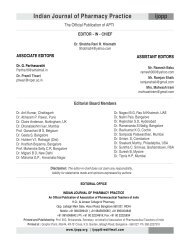Oct-Dec, 2011 - Indian Journal of Pharmacy Practice
Oct-Dec, 2011 - Indian Journal of Pharmacy Practice
Oct-Dec, 2011 - Indian Journal of Pharmacy Practice
- No tags were found...
You also want an ePaper? Increase the reach of your titles
YUMPU automatically turns print PDFs into web optimized ePapers that Google loves.
<strong>Indian</strong> <strong>Journal</strong> <strong>of</strong> <strong>Pharmacy</strong> <strong>Practice</strong>Association <strong>of</strong> Pharmaceutical Teachers <strong>of</strong> IndiaEvaluation <strong>of</strong> the Impact <strong>of</strong> a Pharmaceutical Care Program for Diabetes Patients inNepal: A Preliminary Study1, 2 3 4 5Dinesh K.U* , Mohamed Izham M.I ,Alurkar V.M , Pranaya M1 2Department <strong>of</strong> Hospital and Clinical <strong>Pharmacy</strong>, Department <strong>of</strong> Pharmacology, Manipal Teaching Hospital / Manipal College <strong>of</strong> MedicalSciences, Pokhara, Nepal3College <strong>of</strong> <strong>Pharmacy</strong>, Qatar University, Doha, Qatar,4Department <strong>of</strong> Medicine, Manipal College <strong>of</strong> Medical Sciences/Manipal Teaching Hospital, Pokhara, Nepal5Department <strong>of</strong> Pharmacology, College <strong>of</strong> Medical Sciences, Chitwan, Bharatpur, NepalA B S T R A C TSubmitted: 2/11/<strong>2011</strong>Accepted: 19/11/<strong>2011</strong>4Diabetes is a chronic disease condition characterized by hyperglycemia, which if uncontrolled leads to various short terms and long termcomplications. The prevalence rate <strong>of</strong> diabetes is high in Nepal and is expected to rise. This rise is due to low literacy rate, lack <strong>of</strong> publicawareness, lack <strong>of</strong> advanced healthcare facilities and sedentary life style. The contribution <strong>of</strong> pharmacists in diabetes management is so far notdocumented in Nepal. The aim <strong>of</strong> this preliminary study was to assess the knowledge, attitude and practice <strong>of</strong> diabetics, drug prescribingpattern, and the impact <strong>of</strong> pharmaceutical care program on glycemic control, direct cost involvement and patient satisfaction. The study wasprospective and interventional, in which newly diagnosed diabetes patients were enrolled. They were evaluated for their diabetes Knowledge,Attitude and <strong>Practice</strong> (KAP), and satisfaction level by administering the KAP and satisfaction questionnaires at baseline and after two monthspost intervention. The enrolled patients were divided in three groups, control group (n=10), test group-1 (n=11) and test group-2 (n=10). Thecontrol group patients went through their normal care . Both the intervention groups (test group-1 and test group-2) received pharmaceuticalcare emphasized on education and counseling about diabetes, importance <strong>of</strong> medication used and were provided with diabetes booklet, dietchart, medication calendar, while demonstration <strong>of</strong> diabetic kit was specially to test group-2 patients only. Total 31 patients were enrolled [maleswere 22 (70.96%)]. Large number <strong>of</strong> patients were in the age group <strong>of</strong> 51-60 years (n=11, 35.48%). Commonly prescribed drug class wasantidiabetics (n=36, 48%). Biguanides were commonly prescribed drug category accounting for 17 (47.22%) <strong>of</strong> the total antidiabetics.Significant improvement in blood glucose level was observed in test group patients in terms <strong>of</strong> knowledge (score <strong>of</strong> 7.112.32), attitude (score <strong>of</strong>14.77±3.23) and practice (score <strong>of</strong> 9±1.65 check decimal point) after intervention. The overall improvement in KAP scores were foundinsignificant in all the three group patients (P=0.012). Direct cost reduction was noted in all the three groups during their two months studyperiod. The satisfaction level was found significantly higher (P=0.008) in test group-2 patient among the three groups. Present study has showna positive impact <strong>of</strong> pharmaceutical care program among diabetics in terms <strong>of</strong> their KAP improvement. Improvement in the glycemic control andreduction in the prescription cost and economical burden was found after such program which increased the overall patients' satisfaction.Keywords: Diabetes mellitus, Direct cost, Drug prescribing pattern, KAP, Nepal, Pharmaceutical care, Satisfaction.INTRODUCTIONDiabetes is a chronic disease condition characterized by1hyperglycemia. In diabetes there is an increased insulindemand and reduction <strong>of</strong> insulin secretion in the body. Thisleads to abnormal carbohydrate, protein and lipid2metabolism. It is one <strong>of</strong> the most common chronic diseaseAddress for Correspondence:Dinesh K Upadhyay, Assistant Pr<strong>of</strong>essor, Department <strong>of</strong> Pharmacology /Hospital and Clinical <strong>Pharmacy</strong>, Manipal College <strong>of</strong> Medical Sciences/ ManipalTeaching Hospital, Pokhara, Nepal.E-mail: dinesh17dec@rediffmail.com3condition seen in primary care. Diabetes causes disability,premature mortality, loss <strong>of</strong> productivity and increaseddemand <strong>of</strong> healthcare facilities. The prevalence rates <strong>of</strong>diabetes type-2 is rising much higher than type-1 and have4affected 6% <strong>of</strong> people between the age group <strong>of</strong> 20-79 years.Diabetes if uncontrolled can lead to microvascular andmacrovascular complications which can affect the patients'5, 6quality <strong>of</strong> life and lead to morbidity and mortalityThe management <strong>of</strong> type-1 depends upon insulin therapy andtype-2 diabetes is treated by oral hypoglycemic agents7(OHAs). The treatment <strong>of</strong> long term complications like<strong>Indian</strong> <strong>Journal</strong> <strong>of</strong> <strong>Pharmacy</strong> <strong>Practice</strong> Volume 4 Issue 4 <strong>Oct</strong> - <strong>Dec</strong>, <strong>2011</strong> 49
















